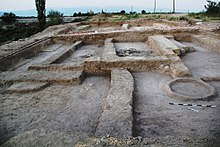
Nakhchivan Tepe (Naxçıvantəpə) is a Chalcolithic settlement in Nakhchivan, Azerbaijan. It is located in Nakhchivan (city) and is dated to the first half of the 5th millennium BC. It is on the right bank of the Nakhchivançay river at the altitude of 850m.[1]
About 5km north of it is located Kultepe-1 site, which was the first Neolithic-Chalcolithic archaeological site to be investigated in Nakhchivan.[2]
Archaeological research in Naxçıvantəpə led by Veli Bakhshaliyev from Nakhichevan, a branch of the National Academy of Sciences of Azerbaijan, began in 2017.[3]
The first settlers of Naxçıvantəpə lived in houses partly dug into the ground, and partly built of mud brick. Similar constructions were uncovered during the excavation of the Ovçular Təpəsi and some other settlements in the area.
Animal bones show that the residents mostly engaged in livestock farming. The inhabitants practised cattle and caprine herding for their subsistence. Only a few horse and dog bones were found. Hunting represented only an insignificant place in the economy.
The upper horizon of the settlement is characterized by rectangular architecture, whereas in the lower levels round dwellings are more common.
- ^ Veli Bakhshaliyev 2021, Archaeological investigations at Nakhchivan Tepe.
- ^ See area map here; in Veli Bakhshaliyev 2021, Archaeological investigations at Nakhchivan Tepe.
- ^ Veli Bakhshaliyev 2021, Archaeological investigations at Nakhchivan Tepe.